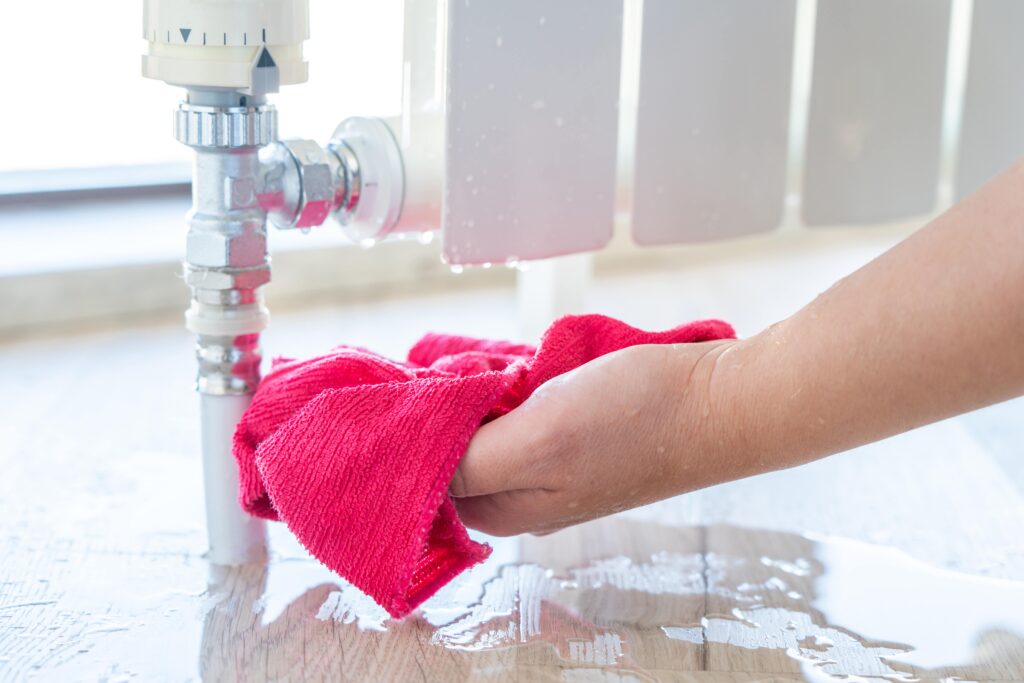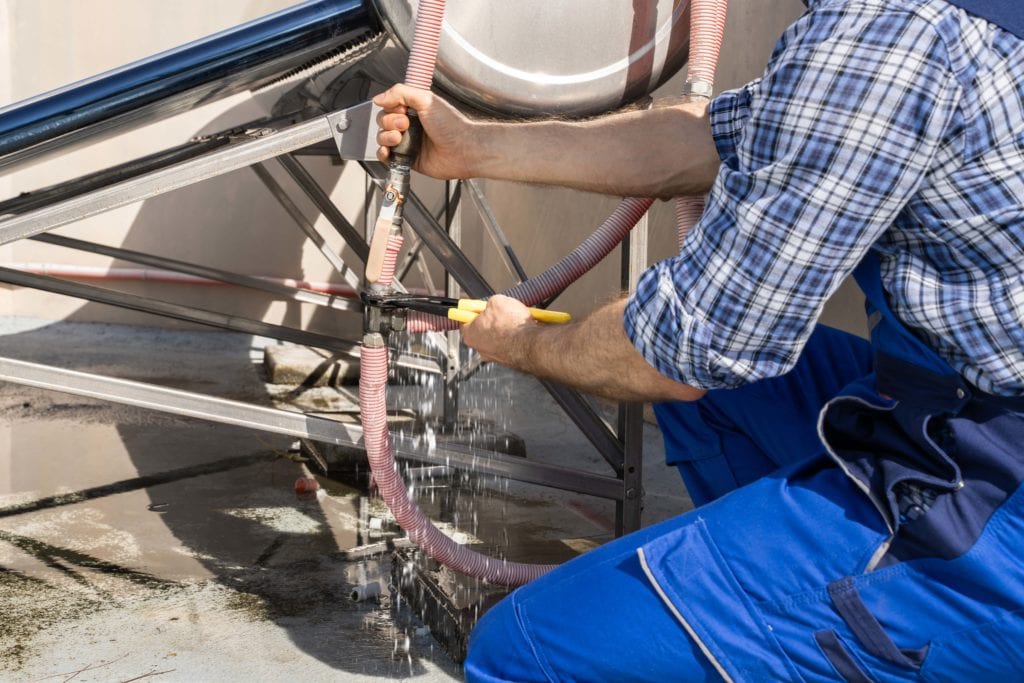Your Furnace Has a Drip
Your Furnace Has a Drip

It’s Wednesday night, you’ve got company coming this weekend, and you need something from the basement. Your oldest goes down to get the roast from the freezer for Saturday night, and when they come back upstairs, they tell you there’s a puddle next to the furnace. You go down to take a look and lo and behold, there’s a puddle!
Great, you think, I had the furnace serviced last summer, so it can’t be from the furnace. Maybe it’s leaking from the ground. It has been wet lately, but you have no history of any wet basement issues. You look again and realize the water is definitely coming from the furnace. But where? In this article we’ll take a look at the three main reasons your furnace is leaking.
STOP – If you don’t want to read any further about the technical parts of heaters and boilers, it’s ok, just give us a call at Mark Lindsay and Son Plumbing & Heating and we’ll come out and diagnose and fix the problem. If, however, you like reading this kind of stuff…
CALL NOW (973) 728-8900 CALL NOW (973) 728-8900What Kind of Furnace do You Have?
There are three basic types of forced air furnaces:
- Natural Draft (less than 79% efficient)
- Induced Draft (79% or somewhat higher)
- 90% + efficient (recuperative furnaces)
Then there’s a hot water heating system:
- Hot Water (Boiler or Hydronic) System
Now we’ll take a look at possible leakage causes for each type.
Natural Draft Furnaces
These furnaces work much like a fireplace or woodstove. They use the draft of the chimney to draw the flue gases up the chimney. They constantly pull air from inside the house to move the gasses up the flue. It’s that simple. It’s also a huge heat loss just like a fireplace. Not that efficient.
Induced Draft Furnaces
An induced draft furnace uses a fan to pull air into the burner, through the combustion changer and heat exchanger. It then pushes the flue gases out of the vent. The fan is located just after the combustion chamber and the heat exchanger but before the vent.
Forced Draft Furnaces
A forced draft furnace uses a fan to push air through the burner, into the combustion chamber, through the heat exchanger, and out through the flue venting system. All oil furnaces and some gas furnaces use a forced draft system. The fan is mounted in front of the burner, heat exchanger and flue vent.
Regular or High Efficiency?
Is your furnace a regular or high efficiency unit? This will also help Mark Lindsay and Son Plumbing & Heating diagnose and fix the problem. It’s easy to tell if your furnace is a regular or high efficiency unit. Take a look at the vent pipe. If it’s a metal vent pipe, it’s a regular efficiency unit. If the vent pipe is a white PVC pipe, it’s a high efficiency unit. The flue gases from a high efficiency unit are cooler so they don’t require a metal vent pipe.
Hot Water (Boiler or Hydronic) System
This system uses hot water to heat your home. It uses a boiler to heat the water, which is then pumped through the house to finned baseboard radiators and cabinet heaters, radiators, unit heaters, manifolds for in-floor radiant heating, and, if you’re lucky, snow melt systems in your driveway and sidewalks.
So, Where’s the Water Coming From?

Good question. There are a number of possibilities. Given the complexity of modern furnace systems, and the possible dangers of working with gas or oil lines, it’s best to have the furnace repairs done by a professional. That being said, if you can possibly pinpoint the area where the water is coming from, that’ll help the HVAC customer service person describe the problem to their repair tech for a faster fix. But, if you don’t know, or can’t tell – just call Mark Lindsay and Son Heating and Plumbing, and we’ll take care of the rest.
Conventional (Non-Condensing) Furnace
Leaking Humidifier
One reason your conventional (non-condensing) furnace is leaking could be the built-in humidifier. Since you need to maintain a comfortable level of humidity in your home, the humidifier adds moisture to the air. It has water flowing to it constantly and needs to drain out. If the drain line clogs, or the unit develops a leak, the water will overflow and end up on your floor. If this is the case, follow these steps:
- Check to see if you have a built-in humidifier. It’s usually mounted on the outside of the furnace and is readily visible.
- Check for leaks or clogs at the water tap line (connects to the cold-water line), the feed line (feeds water to the unit), and the drain line.
- If you find a leak or clog, contact Mark Lindsay and Son Plumbing & Heating to repair the problem. Don’t try to fix it yourself. It’s not a DIY project.
If it’s not the humidifier, then it could be a problem with the vent pipe.
- Inspect your vent pipe for any signs of leakage. It’s the pipe that runs from the furnace to the outside (or to your chimney).
- Also check to see if it’s the right size for your furnace and has a slope to it. If it seems to be too large, or runs horizontally rather than sloping upwards, this could be the source of the water. If the vent is too large or not sloped, the gasses can cool and condense before they get outside. The water that condenses will then leak from whatever openings it can find.
- If it’s neither of these things, then it’s a leaking AC drain line. If it’s warm weather this could be the case. If not, it’s probably one of the other issues or possibly a combination of the two. In any case, contact Mark Lindsay and Son Heating & Plumbing to repair the problem.
High Efficiency (Condensing) Furnace
The main reason that high efficiency heaters create water is that they have two heat exchangers rather than one in a conventional (non-condensing) furnace. These heat exchangers absorb so much heat from the exhaust gasses that the gasses condense into a liquid state, i.e.: water. This condensation forms and is carried out through the condensation line. This needs to be maintained properly to prevent leaks.
If there is leakage, there are a couple of main causes:
- The drain is blocked. One thing you can do yourself is check the drain trap. If that’s clogged, you can clear it using a shop vac. The trap collects dirt and dust over time and can become clogged. If the drain trap is clear, then it’s something else.
- The drain is clogged somewhere along the line. This is not a DIY fix.
- The condensate pump isn’t working right or at all. Again, not a DIY fix.
- The humidifier isn’t working properly. Don’t even think about it. Just give us a call.
If you’re having any of these issues, contact Mark Lindsay and Son Heating & Plumbing to schedule a visit.
Hot Water (Boiler – Hydronic) Heating System
If you have a hot water (hydronic) heating system, leaks will probably occur at some point. Unlike forced air systems, they can be a bit more complicated to figure out. Between the piping going to the boiler, the boiler itself, the accompanying systems, and so on, it can get frustrating. Here are some reasons why your boiler could be leaking and why you’re hot under the collar.
Leaking Pipe Fittings/Poor Installation
It could be due to badly soldered or loose pipe fittings. If either isn’t done properly, they’re going to leak. Guaranteed. For threaded fittings, you can try tightening it a ¼ turn. If that doesn’t do it, please contact Mark Lindsay and Son Plumbing & Heating and have us take a look at it. It may just be a case of no plumbing (Teflon) tape on the threads or it could be something else.
If the soldered joints are leaking, there’s no alternative but to have Mark Lindsay and Son Plumbing & Heating come in and re-do the whole installation. Expensive, but necessary for proper operation and safe operation.
Boiler Pressure Valve Malfunction
The boiler pressure valve, sometimes referred to as the boiler pressure safety valve or T&P (Temperature & Pressure) valve is a highly important part of your boiler. It relieves excess pressure in the tank and if it’s faulty, it can be a highly dangerous situation. You should inspect it regularly. If it’s leaking or your boiler pressure is above normal, contact Mark Lindsay and Son Plumbing & Heating immediately and have the situation remedied ASAP. Calcite and limescale buildup can raise the pressure inside your tank and if the valve isn’t working properly, it can be disastrous. Not something to put off until later.
Corrosion
Corrosion, the enemy of any system that handles water. Corrosion in the pipes or tank of your boiler can lead to leaks. In spite of the manufacturers’ best efforts, corrosion will occur in your boiler’s components. Have Mark Lindsay and Son Plumbing & Heating examine any possible corrosion problems. If it’s minor, a boiler service call will take care of it. If it’s extensive, you may have to replace your heating system.
Bad Rubber Seals in the Boiler Pump
Hot water systems use pumps to circulate the water through the piping in your house. The seals will get old and crack or be less effective at their job. Worn out or cracked seals are a common cause of leaks. The seals are inexpensive, and Mark Lindsay and Son Plumbing & Heating can replace them easily on a service call.
Faulty Expansion Tank
Your furnace’s expansion tank gives your system a place for the hot water to go when it expands, and it also relieves pressure. To determine if it’s the source of the leak, watch it and see when the water starts leaking. If it leaks only after the boiler’s been on for a while, it could be the expansion tank. Have Mark Lindsay and Son Plumbing & Heating check it out to see if the tank is faulty and needs to be repaired or replaced.
Heat Exchanger Corrosion
Your heat exchanger can leak due to corrosion, cracks, or faulty connections. Heat exchangers are one of the most expensive parts of your heating system and should be maintained and checked regularly. If you inspect it and see corrosion or cracking, you’ll probably have to replace your entire system, and that gets expensive. It could also just be a bad connection, which is much easier and less costly to fix. Have Mark Lindsay and Son Plumbing & Heating give your heat exchanger a thorough inspection to diagnose and repair the problem.
Old Age
The leaks may just be a sign of old age. Boilers and their related systems do age and wear and tear take their toll. Once your system gets past a certain point, regular use will cause corrosion, rust, cracks, and possible mineral buildup in the piping and expansion tank. While it may be working okay, a new system would be a good investment.

Aside from the lower maintenance and repair issues, newer systems are much more energy efficient and will reduce your heating bills in the short AND long term. Talk to Mark Lindsay and Son Heating & Plumbing to take a look at your system and see if it does need replacing. If so, we will schedule an installation as soon as possible, especially if cold weather is approaching or already here. The last thing you need is your system to fail during cold weather all while having to wait for a new installation to have heat again.
What to do Next?
If you’ve discovered a furnace leak and have (more or less) figured out where it’s coming from, contact Mark Lindsay and Son Heating & Plumbing. We’ll be able to validate your diagnosis and fix the source of the leak. With any luck it’ll be a minor issue and be a relatively simple fix. If it’s something more serious, then we’ll let you know. In any case, repairing the leak is a matter of cost and safety. By neglecting a problem, it’ll only get worse and more expensive to fix.
Financing is Available!
If you get to the point of considering replacing your heater, or any of your comfort equipment, we have several financing options available. Often, the utility cost savings of a new unit will more than pay for the monthly financing. That way, you’ve added a major upgrade to your home (increasing your home’s value). And this will all be financed by what you would have already spent in utility costs. Not to mention no leaks, more comfort, and the no-leak worries peace of mind.
Learn More About Heating Repair in West Milford, NJ & Beyond
Check out more of our blog posts below for some helpful info, expert tips & more!
- When to Call a Professional for Heating Repairs
- The Most Common Heater Problems & How to Fix Them
- No Heat? 5 Things to Check Yourself
- Emergency Heating Repairs: What to Do When Your Heat Stops Working
- Troubleshooting Your Boiler Woes: Expert Solutions and Quick Fixes
- 5 Reasons Your Furnace Is Failing

